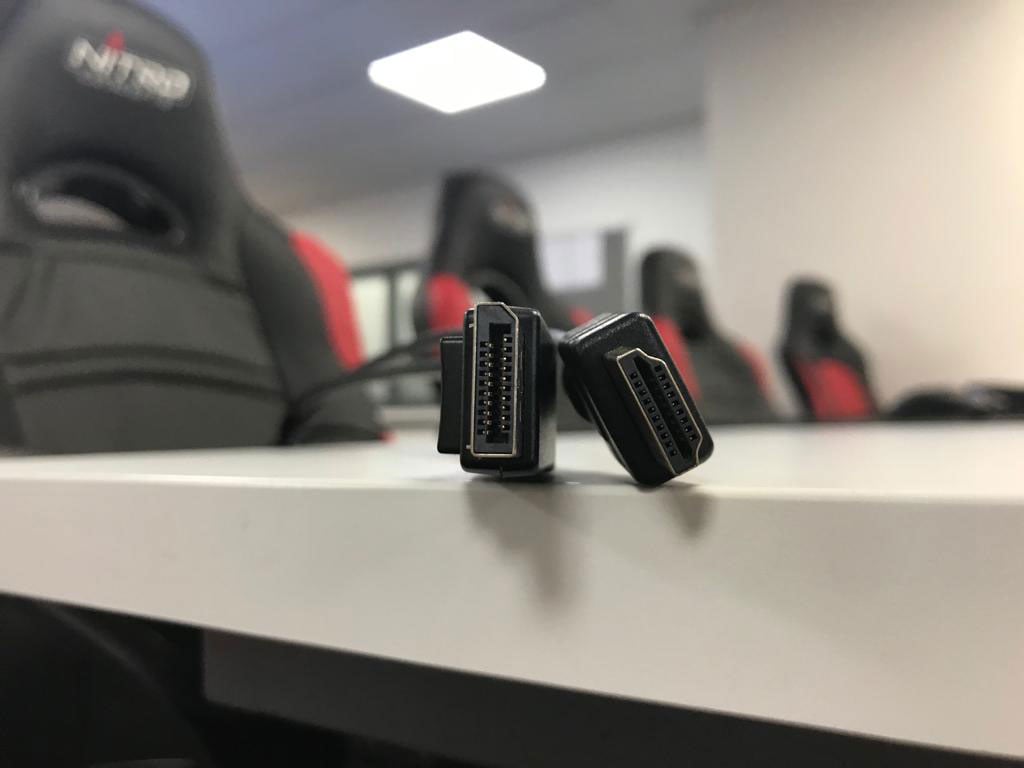Which Cable is Best for Your Monitor, HDMI or DisplayPort
Not sure what’s best connection to use for your computer monitor, HDMI or DisplayPort cable? While both are used for transmitting video and audio from your computer to the monitor (source to display), they both have distinct features, compatibilities, and capabilities.
There are many factors to think about before choosing the right cable for your monitor. In this blog, we will talk about those factors and learn the differences between DisplayPort and HDMI cables.
If you're currently running an 144hz Monitor and you're unsure as to whether it's running at the right settings, you can check out our guide on how to change a monitor to 144hz here.
History of HDMI and DisplayPort
Developed in 2003, High Definition Multimedia Interface or HDMI was launched by display manufacturing brands that concentrated on image-driven applications, namely Sony, Phillips, Toshiba, and Samsung. Therefore, HDMI is commonly found in home appliances, such as home desktops, projectors, and television sets.
In 2006, PC and Chip manufacturers created DisplayPort interfaces for computer displays and IT equipment. They came as an advanced version of VGA and DVI standards.
HDMI connectors are available in 5 shapes or types and DisplayPorts are available in two sizes.
The Kind of Monitor You Use
The type of connector you choose will largely depend upon the type of monitor you use. Usually, gaming computers come with both of these ports that look remarkably similar, but are vastly different.
The question is what you want to do – use the computer for gaming, or photo/video editing or for file transfer. While your monitor may support both connections, it will probably support only certain versions that will depend upon the resolution and the refresh rate of the monitor itself.
HDMI Connection
HDMI is the most familiar standard of cable because it is found on TVs, games consoles and set top boxes. It is used to send high-definition video and audio frequencies. HDMI currently has five different revisions. However, on most modern monitors, you will find the following three versions only:
HDMI 1.4: Supports 4K resolution at 24Hz and 30Hz refresh rate speed or 1080 at 120 Hz.
HDMI 2.0: Provides 4K resolution at 60 Hz speed and also processes HDR video streaming (on advanced versions HDMI 2.0a and HDMI 2.0b).
HDMI 2.1: Powers-up up to 10K resolution at a 120 Hz refresh rate. It also comes with enhanced HDR version with Dolby Atmos, enhanced Audio Return Channel (eARC), DTS:X audio, and dynamic metadata transfer.
Apart from these specifications, all HDMI ports function perfectly well with AMD’s FreeSync technology that prevents screen tearing when playing video games. They are able to do it by matching monitor refresh rate to video card’s output refresh rate.
On the downside, HDMI ports do not support G-Sync technology.
DisplayPort Connection
DisplayPorts are more commonly used as gaming PC monitors connectors. While DisplayPorts allow high-definition video and audio transfer just like HDMI, their compatibility and standards are different. The common types of DisplayPorts available are as follows:
DisplayPort 1.2: Transfers up to 4K resolution at 60Hz refresh rate along with AMD’s Free Sync support.
DisplayPort 1.3: transfers up to 4K resolution at 120Hz speed or up to 8K at 80 Hz refresh rate.
DisplayPort 1.4: Supports HDR connectivity and 8K resolution at 60Hz refresh rate speed.
Though they look less powerful than HDMIs, DisplayPorts support a wide range of popular PC monitors, including Acer.
It also comes with additional guaranteed benefits, such as:
Supports both AMD’s FreeSync and Nvidia’s G-Sync (missing in HDMI) at the same time.
Offers tear-free gaming experience regardless of the type of brand card you use.
One DisplayPort can perfectly drive multiple monitors, eliminating you from using multiple ports.
You can use your Laptop to send signals through a USB-C port via DisplayPort.
DisplayPort also supports all common 3D video formats.
Differences Between HDMI and DisplayPort
The maximum bandwidth of most ultra-version of DisplayPort is DP 1.2 cable and 17.28 Gbps. The maximum bandwidth of the most advanced version of HDMI is 1.4 cable and 10.2 Gbps.
HDMI has an Audio Return Channel (ARC) feature, which means not only the surround-sound AV-receiver can send the audio to the TV, but the sound vibration can flow to other directions as well. This is perfect for smart TVs.
DisplayPorts support many adapters, have longer cables, can connect to several display standards, and can carry Ethernet signals. HDMI cannot perform any of these functionalities.
If your purpose is to find a connector for your Smart TV that has the ability to send surround sound, go for HDMI cable. But, if you are looking for gaming, high refresh rate, high bandwidth supporting cables, and multiple displays, choose DisplayPort.
Posted in TechShot
Published on 27 Nov 2019
Last updated on 09 Feb 2023
